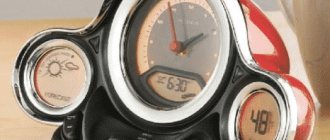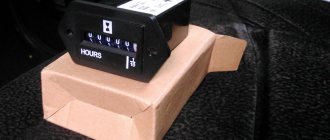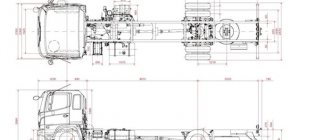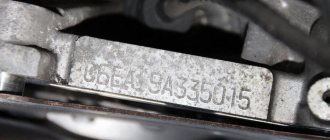Everyone knows how to approximately determine the service life of a passenger car engine - by mileage. Of course, it is important to take into account other factors, such as operating conditions (climate, road quality, load), but in general the condition of the engine is judged by the distance traveled by the car and is rarely mistaken. The more the car has driven, the more the engine has been “overclocked”, the more its components and parts are worn out, and the sooner they will require replacement or preventive maintenance. But how to calculate the engine hours and work volume of tractors, agricultural trucks, and snowplows? Most often, during operation, they travel a very short distance, but they experience a noticeable load. In order to correctly determine the degree of wear, you need to know what engine hours are on a tractor and other equipment and how to count them.
How is engine hour calculated correctly and why is this parameter needed?
The duration of engine operation is measured in units - engine hours. This indicator is not equal to the usual hour. It is less or more than one hour depending on certain factors. The calculation is carried out taking into account the operating mode of the vehicle. The crankshaft revolutions are calculated using a tachometer. 1 engine hour does not have an exact definition of time. It can be converted to astronomical hour by performing a calculation. The engine hour is considered a special unit for determining the load of a running engine. It is equal to one usual hour of crankshaft operation at moderate/idle loads. In 60 minutes the engine makes approximately 1600 revolutions per minute. This indicator is not equal to operating time or mileage. It is measured for small-capacity vehicles, for example, motorcycles, as well as for special equipment, the performance of which is not assessed by distance.
Simply put, an engine hour is one hour of engine operation at rated speed. If the engine operates in different modes (highway, traffic jams, idling), then calculating this parameter is difficult. There are modern German cars that are already equipped with an hour meter. This device itself signals the owner when it is necessary to change the oil. Cars from German manufacturers are usually equipped with a turbine. Oil passing through it quickly reduces its quality. Therefore, its replacement is carried out according to engine hours. Other foreign cars do not have the specified counter.
Features of engine hour calculation
To perform the calculation, you need to know how the unit of measurement is fixed. When the engine starts, a counter (electronic, mechanical) is turned on, recording the frequency at which the shaft rotates. The indicator is displayed on the indicator. Such a tool for calculating engine hours makes it possible to determine the duration of its operation at any time. The calculation is based on the number of revolutions made by the shaft in one minute. At idle and under load the indicator is different. Engine hours are calculated to find out approximately how worn out the mechanical moving parts of the unit are. The formula for calculation is simple, based on the number of revolutions.
Counting methods:
- The most accurate is based on the number of crankshaft revolutions. One engine hour corresponds to approximately 96 thousand revolutions.
- For spent fuel.
- By time. This is approximately 1 hour of engine idling.
Many users want to learn how to calculate engine hours (motor hours). Implementing counting is not that easy. In any case, the data obtained are relative. Counters allow you to obtain accurate data and assess how worn the engine is. The parameter can be equal to one real hour, or it can be different. But in any case, one engine hour is equal to 1 hour of engine operation at idle speed.
Why do you need to count engine hours?
Engine hours will help you find out how much the resource has been used up. The greater the number of hours that have been measured, the sooner the day will come when you will need to change consumables (for example, change the power steering oil) or do maintenance. After the necessary manipulations, the clock will be updated and the countdown will begin again. Therefore, knowledge of operating hours makes it possible to monitor indicators and indicates the importance of replacing parts. Each power unit has different characteristics. There are no uniform maintenance standards for a strictly defined period of time. The manufacturer specifies the conditions for replacement in the technical documents of the equipment. In fact, they may vary depending on operating conditions. You can calculate engine hours using the methods indicated above. There are modern devices that make it possible to accurately calculate engine hours. Their operation makes it possible not to calculate the indicator using a formula. A special sensor displays the parameter.
How many engine hours in one hour
One engine hour does not equal an astronomical hour. The number of engine hours depends on the number of crankshaft revolutions that it makes in 1 hour under different loads. You can correlate the desired parameter with respect to the standard hour using a simple formula.
Algorithm:
- When the engine is idling, the number of engine hours is 60 minutes (1 astronomical hour).
- Under moderate load, the number of revolutions increases by a third. Then 40 minutes corresponds to 1 engine hour.
- If the loads are high, then 20 minutes of real time is 1 engine hour.
Using this algorithm, you can easily convert engine hours to hours. The exact value cannot be determined. The formula makes it possible to calculate engine wear taking into account loads. There will always be factors that will cause a difference from the actual time. The calculation results will be different for gasoline and diesel engines. The second one is considered more powerful, so it is used in agricultural machinery. It completes a given amount of work in less time.
Difference between engine hour and machine hour
The unit of measurement that determines the operating time of the engine is the engine hour. It shows how many revolutions the crankshaft was able to complete in an hour. In contrast, a machine hour indicates how much time was spent making a product. The indicator is needed to determine the performance of the device. Thus, engine hours and machine hours - the difference in these concepts is obvious. They have nothing in common with each other. It is impossible to convert engine hours to machine hours for this reason.
Machine hours reflect the amount of time required by one unit of equipment to complete a certain amount of work. If, for example, a machine clears snow from the street for 7 hours, then it is said that it has worked 7 machine-hours. This parameter is important for a vehicle fleet. Specialists calculate the load and plan equipment visits. Thus, machine hours determine the overall amount of work of special equipment, and engine hours measure the spent life of the engine.
How to calculate engine hours on construction equipment
Previously, this indicator was calculated only for construction and agricultural machinery. This is explained by the fact that knowing the mileage, it is impossible to know the real condition of the nodes. You can find out the degree of wear and tear using engine hours. Different vehicles have their own meters. The algorithm is based on the fact that idling construction equipment works out 1 engine hour in one hour of real time. It accelerates by a third under normal load. Then one engine hour corresponds to 40 minutes. If the load on the equipment is intense, the motor wears out even faster. If a meter is used, then maintenance is planned in a timely and competent manner. Various sensors have been developed for construction equipment. It all depends on the device they control. All types of counters are based on time counting. The difference lies in the starting point. There are sensors triggered by vibration, switching on, etc. Electronic and electromechanical watch instruments are used.
How to count engine hours on a tractor
For users of agricultural machinery, the concept of engine hour is of great importance. For measurement, a special sensor is provided in the engine. After every hour of full engine operation, it fires. Thanks to this, the mileage of the agricultural unit is monitored. This makes it possible to determine the degree of engine wear. The engine hours on a tractor are a counter that starts from the moment the engine is started. The counter can be mechanical or electronic. The device monitors the shaft speed and transmits the data to the indicator. This allows you to set the duration of the engine operation for a specific time. The main role here is given to the crankshaft revolutions per minute. The engine hour of a tractor is not equal to one real hour. By determining the engine hours, the specialist will find out how worn out the engine mechanisms are.
This is found out using the formula:
- One hour of engine operation at idle speed is equal to an hour in real time.
- The engine operating hour in standard mode is 40 minutes of real time.
- The engine hour of intensive loads is equal to 20 standard minutes.
The main components of the meter include an engine operating mode indicator, a time sensor, and a recorder. Simple tractor engines are equipped with mechanical meters. They are connected through a gearbox. The operating time of such devices is calculated by the number of revolutions. Tachometer counters are considered the most acceptable. They take into account the number of working hours and the load on the motor.
Why are motorcycle watches needed and useful for a biker?
You need to know this parameter in order to calculate the operating interval of the bike. For measurement, a sensor is used that is triggered hourly. Having found out the number of engine hours, the biker will calculate the percentage of wear on the working parts of the engine. It is better to convert them to kilometers. Then you can find out how much fuel the motorcycle needs. There is no one formula for determining kilometers. In order to calculate this, you need to look at the technical documents for the device.
Calculation of fuel consumption of a walk-behind tractor
Many owners of summer cottages and not only them often wonder how it is possible to calculate the fuel consumption of a walk-behind tractor during a certain operation.
It is possible to calculate the gasoline consumption of a walk-behind tractor only during its direct operation. To do this, you need to fill the fuel tank of the walk-behind tractor to the maximum level with gasoline. Then you need to plow the land. Upon completion of plowing a certain area, it is necessary to measure the area of the plowed area. After this, calculate how much fuel was spent on plowing this area. Likewise for all other types of work (potato harvesting, mulching, mowing, etc.)
This is calculated using electronic scales. A simple container of fuel is taken and its specific gravity is measured. Then the scales are tared. After this, you need to add gasoline to the tank to the previous level and be sure to put the fuel container back on the scales. Electronic scales will show the difference between fuel cans. This difference will be the final indicator of fuel consumption per area of land on which the work was done. Unlike the first case with special equipment, here fuel consumption is measured in kilograms.
It is worth remembering that the operating speed of the motorized cultivator should be approximately from 0.5 to 1 km per hour of operation. Based on this, a general calculation of fuel consumption by hour is made. According to established standards, there is data from walk-behind tractor manufacturers on average fuel consumption per hour of operation. For low-power walk-behind tractors with a capacity of 3.5 hp. consumption ranges from 0.9 to 1.5 kg per hour of operation.
Medium-power walk-behind tractors consume an average of 0.9 to 1 kg/hour. The most powerful devices consume from 1.1 to 1.6 kg per hour.
How to convert engine hours to kilometers
There is no exact formula for converting the parameter into kilometers. Engine hours in km for passenger cars are calculated as follows: 1 required unit is equal to 12-14 km of driving at a calm pace at moderate speed. In practice, the standard interval for changing oil and other consumables is 15 thousand km. If the conditions change: aggressive driving, bad roads, towing, transporting goods, then the engine hours go much faster. Their number exceeds the mileage if the car is often idled or is driven on busy roads. This results in resource consumption when the car is stationary. It is better to convert engine hours into kilometers and focus on them rather than mileage. This will allow you to replace consumables in a timely manner.
It is important to convert engine hours into kilometers for those drivers who work far from specialized assistance points (extreme recreation, forest area, etc.). This way they can prevent breakdowns in time. If you can’t rely on mileage, it’s better to install a meter. The specifics of converting MP to km depend on the specific enterprise. There are agricultural companies that equate one engine hour with a distance of 16 km. Others take 20 km to be 1 MCH. The type of work is decisive for the calculation.
Comments (10)
In general, the article is about nothing! There is no useful or useless information in it.
It’s definitely useful for those who were not previously familiar with the concept of engine hours. It is the engine hours that justify the advisability of changing engine oil at reduced intervals (for example, once every 7,500 km), and not just in case.
Alexey, many come to it in search of a formula for calculating mileage in engine hours. Meanwhile, such a formula cannot exist in principle, since it is impossible to calculate mileage in engine hours, because the odometer calculates mileage as the mileage of a car, and engine hours - roughly speaking, then in crankshaft revolutions.
It's like calculating the water consumption in a house based only on the length of the pipeline.
“Many people come to it looking for a formula for calculating mileage in engine hours.” It's actually simple. Engine hours take into account the work of an industrial engine. A car engine works in tandem with a gearbox to reach the required speed. An industrial engine operates constantly loaded - we assumed that the conditions were equivalent if the car was constantly moving in third gear at a speed of 60 km/h = 250 engine hours x 60 km/h = wear and tear on the car engine as for 15,000 kilometers or in the readings 250 engine operating hours Operating conditions can now be determined by submitting the engine oil for TBN analysis. In relation to the question: “after what period should I change the oil in the internal combustion engine?”
“It is the engine hours that justify the advisability of changing engine oil at reduced intervals (for example, once every 7,500 km), and not just in case.” It would be more correct and accurate and more expedient to analyze the oil for its alkaline number. Frequent oil changes without reason can harm the internal combustion engine, if, for example, the additives do not work out (in case the detergent additive does not work out (for example, they chose the oil change period poorly - from the “ceiling” or “you can’t spoil the porridge with oil”, which at this time Since a detergent additive must be turned on to combat ash content on the walls), the oil channels will begin to coke, which ultimately threatens an accident.
How to determine the oil change interval based on engine hours
Car enthusiasts are guided by the average: every 10-15 thousand km it is necessary to change the oil. Experts recommend relying not on mileage, but on engine hours. This reduces the interval between replacements by 2 times. Certain oils need to be renewed after a certain amount of time, even if the car has low mileage. Otherwise, the wear of the motor will be great, since the protective qualities of the lubricant are lost.
The following types of oils are used:
- Mineral. Change after 150 MH (motor hours).
- Semi-synthetic. Replacement is done after 250 MH.
- Synthetic. Change after 250 - 350 MH.
It is not recommended to exceed the specified limits, since the lubricating composition loses its properties. Exceeding the hours threatens engine wear. It won't last long. Car owners must determine the hour to prevent breakdowns.
Design and principle of operation of instruments for measuring engine hours
A counter helps calculate engine operating time. After a certain time has passed, it beeps or turns on a relay. The meter makes it possible to carry out timely maintenance, routine replacement of parts, and repairs. The counter continuously counts the time while it is turned on. When turned off, the countdown stops. When it is turned on again, the count starts from the extreme value, and not again. The MC counter tracks reserves. It measures the available life of the motor and controls the time of its maintenance. Using such a device, the car owner can monitor the performance of the engine. As a result, this reduces costs and minimizes downtime.
Features of hour meters and methods of their use
The counter counts seconds, minutes. When the hour ends and its value approaches 59.59, one is added to the hour, seconds and minutes start from 00.00. When the engine hour calculation reaches a critical value, a signal sounds. Thus, the device informs the owner about the need to monitor the engine condition.
Types of hour meters:
- Non-resettable. Calculates equipment operating time from one second to 9999 hours. Does not reset.
- Resetable. Counts from seconds to 9999 hours. There is a possibility of resetting.
The design and quality of the meters are different. The devices available on the market are divided into groups according to functionality:
- Electronic.
- Mechanical.
- Electromechanical.
- Digital.
A mechanical device is considered a classic device. It is made on the basis of a spring mechanical watch with automatic winding. Works when the engine is running. Meters of this type are rarely used, since they have been replaced by modern, convenient devices. Electromechanical meters are considered more reliable, accurate, and simpler. They have not lost their relevance for many years. They contain an electromechanical unit. A quartz resonator keeps track of the clock. Unlike such devices, electronic meters have a recorder (indicator). This is usually an LCD display. They are compact in size and reliable. When using an electronic device, the user must protect the readings and store the data.
New modern meters are digital. They not only record operating time, but can monitor other indicators. The design is based on a microcontroller. The digital device can be programmed to meet specific needs. Such a device needs protection against data reset.
The functionality of MCH counters also varies. Their functionality may be basic. Then the device only counts the operating time of the motor, without taking into account other parameters. The device can record tachometer information and exhaust gas temperature. Some models are equipped with an alarm that goes off when the time runs out.
How does the hour meter work?
The device is operated according to the manufacturer's instructions. If the hour meter is professional, then it is installed and configured by qualified specialists. Household devices are used according to a simple principle. They are available for use. The owner must periodically check the device. If a malfunction occurs, the meter is replaced or repaired. The device must be protected from liquids, falls, and shocks. If used correctly, it will work for many years.
The counter operates simply. The clock mechanism is activated when the engine is started. All readings are reflected on the indicator. If the engine has stopped, the operation of the device ends. For this reason, operating time is only recorded when the engine is running. The device calculates the hour in the manner provided by its design.











